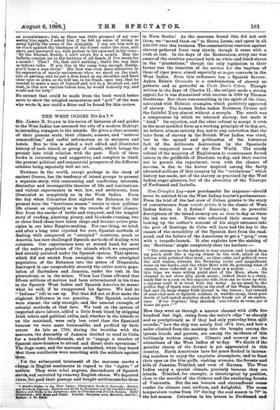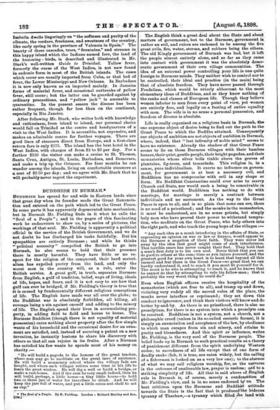THE WEST INDIES TO-DAY.*
Mn. JAMES H. STARK in his series of histories of and guides to the West Indies has assumed the role of a modern Hakluyt to intending voyagers to the islands. He gives a clear account of their present state, their climate, seasons, and "natural commodities," and useful information as to steamers and hotels. But to this is added a well edited and illustrated history of each island, or group of islands, which brings the present into vivid relation with the past. Each of these books is interesting and suggestive, and complete in itself, the present political and commercial prospects of the different colonies being especially well set out.
Nowhere in the world, except perhaps in the story of ancient Greece, has the tendency of island groups to present a separate story, with contrasting and conflicting interests, dissimilar and incompatible theories of life and institutions, and violent experiments in war, law, and settlement, been illustrated so completely as in the West Indies. From the day when Columbus first sighted the Bahamas to the present hour the "hurricane season" recurs in their political life almost as regularly as in the records of their climate. Bat from the smoke of battle and conquest, and the tangled story of trading, planting. piracy, and blockade-running, two or three fixed ideas have taken shape and become active prin- ciples in our later Empire-making. For one thing, we tried, and after a long trial rejected for ever, Spanish methods of dealing with conquered or " occupied " countries, much as America has now challenged Spanish methods of dealing with colonists. Our experiments were at second hand, for most of the native population of the islands which we conquered had already perished under the Spanish system. That system, which did not shrink from sweeping the whole aboriginal population of the Bahamas into the mines of Hispaniola, destroyed in one unspeakable atrocity the entire native popu- lation of Barbadoes and Jamaica, under the lash in the plantations, or in the mines. When Las Casas affirmed that fifteen millions of natives had been exterminated in his time in the Spanish West Indies and Spanish America he meant what he said, if he exaggerated his figures. We had no "Indians" left to use up. But that did not at first make the slightest difference in our practice. The Spanish colonies were almost the only example, and the nearest example, of colonial methods at that date. We took on the system of imported slave labour, added a little fresh blood by shipping Irish rebels and political exiles, and, whether in the islands or on the mainland, were only less cruel than the Spaniard because we were more businesslike, and profited by their errors. As late as 1796, during the troubles with the maroons, the Assembly of Jamaica decided to send to Cuba for a hundred bloodhounds, and to "engage a number of Spanish slave-hunters to attend and direct their operations." The dogs came, and the maroons submitted, when they heard that these auxiliaries were marching with the soldiers against them.
Yet the subsequent treatment of the maroons marks a change in English sentiments in regard to the " rights " of natives. They were rebel negroes, descendants of Spanish slaves, aad recruited by runaway English slaves. We deported them, bui paid their passage and bought settlements for them • Blarles Guides to the West Indira: Illustrated Guide to Bermuda ; History and Guido to Jamaica; Higdon/ and Guide to Barbadoes and the Caribbee Islands; History and Gusts to the Bahamas ; also to Trinidad and British Guiana. Fully Illustrated; wia Maps and Plass. London : Sampson Low, Marston, and Co.; Boston: J. 11. Stark.
in Nova Scotia! As the maroons found this did not snit them, we "moved them on" to Sierra Leone, and spent in all £46,000 over this business. The conscientious reaction against slavery gathered force very slowly, though it came with a rush at last. In the days of the Restoration, every one was. aware of the cruelties practised both on white and black slaves in the "plantations," though the only legislation in their-
favour was the insertion of the service for the baptism of those of riper years, aimed especially at negro converts in the. WestIndies. Even this ordinance has a Spanish flavour. Aphra Behn's Oroonoko is a condemnation of slavery as
pathetic and as powerful as Uncle Tom's Cabin. Though. written in the days of Charles IL, the subject made a strong appeal, for it was dramatised with success in 1696 by Thomas Southerne. But there was something in the spirit of the time, saturated with Hebraic examples, which positively approved of slavery. The human Defoe makes Robinson Crusoe sell the faithful Xury almost without a scruple. The result was.
a compromise by which we retained slavery, bat made it "kind." Its rejection, and the utter refusal to accept it even. in the most modified form as a working principle of to-day, are, we believe, almost entirely due, not to any conviction that the later form of slavery in the British West Indies was cruel, but to the spread and publication of the historical fact of the deliberate destruction by the Spaniards of the conquered races of the New World. The steady refusal of the majority of Englishmen to countenance forced labour in the goldfields of Rhodesia to-day, and their resolve not to permit the experiment, even with the chance of success, is due to the horror inspired among the fairly educated millions of this country by the "revelations" which history has made, not of the slavery as practised by the West Indian sugar-planters, but of the atrocities of the Viceroys of Ferdinand and Isabella.
Tom. Cringle's Log—now purchasable for sixpence—should never be omitted from the West Indian tourist's portmanteatc. From the trial of the last crew of Cuban pirates to the story
of convalescence from vomit° prieto, it is the classic of West Indian fiction. Is it fiction ? Scarcely ; for its powerful descriptions of the island scenery are as true to-day as when the ink was wet. Those who refreshed their memory by looking up the author's account of his ship's entrance into the port of Santiago de Cuba will have had the key to the reason of the invisibility of the Spanish fleet from the road- stead, and the failure of the Americans to get a "peep," even with a torpedo-launch. It also explains how the sinking of the Merrimac ' might completely close the harbour :—
" The entrance to the harbour is very narrow, and looked from my perch aloft like a zig-zig chasm in the rock, inlaid at the bottom with polished blue steel ; so clear, calm, and pellucid were the still waters, wherein the frowning rocks and magnificent trees on the banks, and the white Moro with its grinning tiers of cannon, were reflected as if it had been in a mirror By this time we were within pistol shot of the Moro, where the channel is not above fifty yards across ; indeed there is a chain, made fast to a sock on the opposite side, that can be hove up with a capstan until it is level with the water. As we stood in, tha golden flag of Spain rose slowly on the staff of the Water Battery, and cast its large sleepy folds abroad in the breeze ; but instead of mail-clad men or Spanish soldiers in warlike array, three poor devils of half. naked mulattos stuck their heads out of an embra- sure. '8,ner Capitan; they shouted, 'iota botella de roma, por oi honor del pais ! ' " How they went on through a narrow channel with cliffs five hundred feet high, rising from the water's edge "as sharply and as precipitously as if they had only yesterday been split asunder," bow the ship was nearly foul of4-a tree, and how sailor climbed from the maintop into the boughs among the iguana lizards and parrots, are among the incidents of this brilliantly written chapter. Climate and scenery are the attractions of the West Indies of to-day. We doubt if the peculiar charm of the former is yet appreciated in this country. North Americans have for years flocked in increas- ing numbers to enjoy the exquisite atmosphere, and to feast their eyes on the blue gulfs, rushing streams, the foresta'and hills of Jamaica, Trinidad, and even of Havana. The West Indies enjoy a special climate, precisely because they are islands. Trinidad, for example, is intertropical by position, close to the mouths of the Orinoco and the sweltering forests of Venezuela. But the sea breezes and circumfinent ocean render its climate cool, uniform, and delightful. The mean temperature varies from 76° during the cool season to 79° in the hot season. Columbus in his letters to Ferdinand and
Isabella dwells lingeringly on "the softness and purity of the climate, the verdure, freshness, and sweethess of the country, like early spring in the province of Valencia in Spain." The beauty of these cascades, trees, "fountains," and streams in this happy island which the Indians named Iere, the land of the humming - birds, is described and illustrated in Mr. Stark's well-written Guide to Trinidad. Yellow fever, formerly the curse of the West Indies, is not now found in endemic form in most of the British islands. The cases which occur are usually imported from Cuba, or that bed of fever, the Lower Mississippi and New Orleans. In Barbadoes it is now only known as an imported malady. In Jamaica forms of malarial fever, and occasional outbreaks of yellow fever, still occur ; but the latter can be guarded against by ordinary precautions, and "yellow jack" is amenable to quarantine. In the present season the disease has been rather frequent, though far less than on the continent, especially in Rio Janeiro.
After following Mr. Stark, who writes both with knowledge and enthusiasm, from island to island, our personal choice would fall on Trinidad as the centre and headquarters of a visit to the West Indies. It is accessible, not expensive, and makes an admirable centre for further voyages. There are good lines of steamers direct from Europe, and a first-class return fare is only $175. The island has the best hotel in the West Indies, with charges of from $2 to $3 per day. For a further $150 the visitor can make a cruise to St. Thomas, Santa Cruz, Antigua, St. Lucia, Barbadoes, and Demerara, and make a trip up the Orinoco. For four months he can wander among the islands, living on comfortable steamers at a cost of $2.50 per day; and we agree with Mr. Stark that he will probably never regret the experiment.



































 Previous page
Previous page